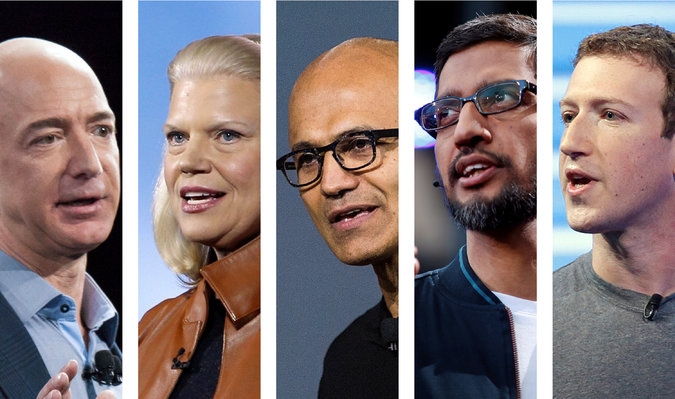Joint compilation: Blake, Gao Fei
Lei Fengnet Note: Stanford recently launched a project named “100 Years of Artificial Intelligence Research†and formulated relevant specific plans (a detailed report on the social impact of artificial intelligence every five years in the next 100 years).

AI Research Trends
Before the millennium, artificial intelligence (AI) attracted much of its appeal from the vision it promised to achieve. But in the last 15 years, most of its promises have already been realized. Artificial intelligence technology has long been in our lives. As they are transforming into the core forces of society, research in the AI ​​field has shifted from simply building intelligent systems to building human-aware, trusted, intelligent systems.
Several factors contributed to the artificial intelligence revolution. The most important of these is the maturity of machine learning —partly achieved through the support of cloud computing resources and extensive web-based data collection. The main reason for machine learning progress comes from "deep learning" - it uses an adaptive artificial neural network training method called backpropagation .
Advances in the performance of information processing algorithms are also accompanied by major advances in hardware technology (such as perception, awareness, and object detection). New markets for platforms and data-driven products, economic incentive mechanisms, and the search for new products and markets have jointly promoted the arrival of artificial intelligence driven technologies. All of these trends drive the following areas of research becoming increasingly popular:
Large-scale machine learning
Most of the basic problems in machine learning (supervised or unsupervised learning) have been thoroughly understood. The main direction of the current efforts is to extend existing algorithms to particularly large data sets.
Deep learning
Deep learning intends to aggregate further in the field of perception (eg voice, speech, and natural language processing)
Enhanced learning
Enhanced learning focuses on decision-making and helps artificial intelligence to more deeply enter and learn from the real world.
robot
Robot navigation (at least in static environments) has largely been implemented. The current research direction is how to train the machine to interact with the surrounding real environment (in a scalable and predictable way).
Computer vision
Computer vision is currently the most prominent form of machine perception. Current research in computer vision focuses on automatically annotating images and videos.
Natural language processing
Natural language processing often comes with automatic semantic recognition and is a very hot area in machine perception. The current research has mainly shifted to developing an accurate and compatible system that can interact with humans through dialogue.
Collaboration system
At present, more and more researches tend to complement the advantages of humans and machines. For example, humans help artificial intelligence systems to overcome their own limitations and can enhance human capabilities for agents.
Crowdsourcing and human computing
At present, research in this field tends to solve problems that cannot be solved by computers by using human intelligence to enhance computer systems.
Algorithmic Game Theory and Computational Social Choice
Internet of Things
Artificial intelligence can make use of a large amount of IoT data to improve. At present, there are a large number of incompatible protocols among these IoT devices. Artificial intelligence can help overcome this difficulty.
Neuromorphic chip
With the help of a deep neural network, dedicated neuromorphic hardware is built.
AI research future general trend
The great success of the data-driven paradigm has replaced the traditional artificial intelligence paradigm.
In the next fifteen years, the research team expects to focus more on the development of human-conscious systems (which means that specific models designed specifically for specific groups of people can interact). In addition, we must develop new and innovative ways to teach robots in an interactive, quantifiable way. In addition, Internet of Things systems (devices, cloud) will also become more and more popular. They can also be considered as artificial intelligence at the social and economic levels. In the next few years, artificial intelligence with new perception/object recognition capabilities and machine platforms that can guarantee human security will grow faster and faster, and those data-driven products will grow further.
The research team also expects some traditional forms of artificial intelligence to be involved, as some researchers are slowly realizing that the inherent end-to-end deep learning approach inherently has inevitable limits. It is hoped that young researchers will not do repetitive work, pay more attention to the remarkable progress in the field of artificial intelligence in the past 50 years, and at the same time pay attention to research related to control theory, cognitive science, and psychology.
Application of AI in different fields
In the future world, or specifically in 2030, what will our life be like?
trafficTraffic is very likely to be the first area in the artificial intelligence that the general public wants to focus on, because the security and reliability of the related AI system is really important. It can be foreseen that autonomous traffic will soon become commonplace. As the artificial intelligence system most people experience for the first time, it will greatly influence public perception of AI.
Some key technologies have long promoted the widespread use of AI in transportation. Compared with 2000, the scale, diversity, and total available traffic data of personal data are quite alarming today through smart phones and various low-cost, high-precision sensors. It is precisely because of these data that real-time traffic, road information forecasting, route planning, carpooling, and self-driving cars become possible.
In the future, artificial intelligence will have smarter cars (autonomous parking, high-speed cruising, route planning, etc.) as well as driverless cars in traffic. (In the near future, sensing algorithms will outperform human performance in driving ability.) ) There are traffic plans (to achieve automatic communication and interconnection between cars and cars), as well as demand-oriented transportation services and smart devices that interact with people.
Home Robot / Service RobotIn the next fifteen years, the common development of mechanical technology and AI technology will help people use home robots safely and reliably. Such robots with special functions will have service functions such as mailing parcels, cleaning offices, and improving safety and security. However, in the foreseeable future, technological limitations and high output required for reliable mechanical equipment will hinder These are commercial productions of robots with special functions. As early as 2001, vacuum cleaning robots had been developed. However, such robots can only clean the trash on the flat ground. In the real home environment, the stairs and corners are often blind areas of this type of robot. In addition, there are still deficiencies in the study of the mobility of robots in the real family environment.
In the future, deep learning and cloud computing will enable home robots to have functions such as voice understanding and image tagging, which will increase interaction between robots and people's family life. In addition, in the process of developing home robots, issues such as emerging ethics and privacy should be considered.
Medical treatmentAll along, AI technology is considered to have broad application prospects in the medical field. In the future, applications based on AI technology can improve the health and quality of life of millions of people. However, the application of AI technology in the medical field depends on the trust of doctors, nurses, and patients, access to policies, laws and regulations, and commercial market support. Similar to the application of AI technology in other fields, data resources play a decisive role. Nowadays, medical data is mainly obtained from the following ways: personal monitoring equipment and mobile applications, electronic medical records in a clinical environment, and assistive robots for medical procedures and surgery. With the support of large amounts of data, the main applications of this technology include medical analysis, support for clinical decision making, monitoring and counseling of patients, automated equipment that can assist in the operation or care of patients, medical system management, research and development of medical robots, mobile health applications, and elderly care Wait.
educationIn the past fifteen years, great progress has been made in the application of AI technology in the education industry. Although quality education requires interaction between teachers and students, AI can improve the level of education in all aspects, in particular, it helps to achieve large-scale personalized learning. Similar to the application of AI in the medical field, how to better communicate and interact with each other, face-to-face learning and AI technology will still be a major challenge.
For a long time, robotics has been a popular teaching equipment. It is representative of teaching robots, intelligent teaching systems and online learning that can improve the academic performance of students (taking large-scale open online courses, Wikipedia and Khan Academy as examples. ). In addition, AI technology (including deep learning, natural language processing, and other AI technologies) can also be used for learning analysis, mainly analyzing students' learning input, behavior and results. At present, the application of AI technology in schools has not yet been carried out on a large scale. To a certain extent, it is mainly due to lack of funding sources and large amounts of data to improve the effectiveness of the technology.
Anxious about the development of AI and the idea of ​​coping with it
In the foregoing, we mentioned that we are looking forward to the future development trend and application prospect of AI technology. Related parties in the industry will not be afraid of the potential ethical issues that may arise in the process of research and development and improvement of this technology. Yesterday, researchers from Alphabet, Amazon, Facebook, IBM and Microsoft came together to discuss the impact of AI on human work, transportation and even war. The main purpose of these industrial research fellows is to ensure that AI research can benefit human beings, rather than threaten human life and survival. Eric Horvitz, a researcher from Microsoft, emphasized the importance of industry efforts.

The main concern of the technology industry is whether it should establish legal restrictions on AI research work . Therefore, they are trying to create a self-regulatory organizational framework , although it is not clear how this self-regulatory mechanism will operate.
During the discussion, the authors of the Stanford report agreed that since AI technology can be used in many areas, it is impractical to monitor and control AI research and development, and the risks to be encountered and problems to be considered. It is also varied.
In the report, Dr. Stone proposed: "To increase the awareness and professionalism of AI in various government departments", this will increase the public and private investment in AI research and development.
David Kenny, general manager of IBM's Worthington Artificial Intelligence Research Department, believes that the government should assume responsibility for the supervision of artificial intelligence, but usually policy execution always lags behind technological development.
The five companies jointly drafted a memorandum and plan to announce a new self-regulatory organizational framework in mid-September. One of the unresolved issues is that, according to a person involved in the negotiations, Google DeepMind, a subsidiary of Alphabet, requires each company to independently participate in the development of a self-regulatory organizational framework.
The AI ​​industry is working together to build a Global Network Initiative similar to the Universal Declaration of Human Rights, requiring companies and non-governmental organizations to focus on freedom of speech and privacy.
Reid Hoffman, the founder of LinkedIn, is an artificial intelligence researcher who is solely involved with the MIT Media Lab to discuss funding for this project to explore the socio-economic impact of artificial intelligence. MIT and the industry are working together to connect technological advancement with socio-economic policy issues. The MIT team has begun to discuss the design of "social participation" new AI and robot systems.
The phrase "social participation type" comes from people's long debated design of computer systems and robot systems that can communicate with humans. For example, Pentagon has recently advocated a military strategy that advocates the use of AI technology so that humans can continue to control life and death rather than granting this responsibility to machines.
The director of the MIT media lab and the New York Times board member Joichi Ito said: "The key point I want to point out is that computer scientists are not yet able to communicate perfectly with social scientists and philosophers, and we want to increase policy for those who can Contribution to the support of social scientists."
The Stanford report attempts to define the impact that computer and robot systems that can imitate human capabilities will have on a typical North American city citizen. The report author explores eight aspects of artificial intelligence that will affect modern life (medical, educational, and recreational). And the impact of work, etc., but did not discuss the application of artificial intelligence in military warfare. They said that the application of AI in the military field is beyond the scope of its current research, but it does not rule out the future application of AI in weapons.
In addition, the report does not take into account some computer scientists' view of the "singularity" of machines - that is, machines will become more intelligent and may even threaten humans. Given the convenience that future artificial wisdom will bring us, are these possible risks that we can accept?
PS : This article was compiled by Lei Feng Network (search "Lei Feng Network" public number) and it was compiled without permission.
Via Stanford/NYTimes
ZGAR PCC KIT
ZGAR electronic cigarette uses high-tech R&D, food grade disposable pod device and high-quality raw material. All package designs are Original IP. Our designer team is from Hong Kong. We have very high requirements for product quality, flavors taste and packaging design. The E-liquid is imported, materials are food grade, and assembly plant is medical-grade dust-free workshops.
From production to packaging, the whole system of tracking, efficient and orderly process, achieving daily efficient output. We pay attention to the details of each process control. The first class dust-free production workshop has passed the GMP food and drug production standard certification, ensuring quality and safety. We choose the products with a traceability system, which can not only effectively track and trace all kinds of data, but also ensure good product quality.
We offer best price, high quality Vape Device, E-Cigarette Vape Pen, Disposable Device Vape,Vape Pen Atomizer, Electronic cigarette to all over the world.
Much Better Vaping Experience!


ZGAR PCC KIT E-Cigarette Vape Pen,ZGAR PCC KIT Disposable Device Vape,PCC SET,ZGAR PCC KIT Vape Pen Atomizer,ZGAR PCC KIT Disposable E-Cigarette OEM vape pen,ZGAR PCC KIT electronic cigarette
Zgar International (M) SDN BHD , https://www.szvape-pen.com